Dr. Shai Izraeli, MD, en ledande expert inom pediatrisk hematologi-onkologi, förklarar hur precisionsmedicin revolutionerar behandlingen av barnleukemi. Genom avancerade genometriska verktyg mäts minimal residual sjukdom (MRS), vilket möjliggör riktade terapier. Detta maximerar botandegraderna samtidigt som toxiciteten från kemoterapi och behovet av benmärgstransplantationer minskar.
Precisionsmedicin vid barnleukemi: MRD-testning och målinriktad terapi
Hoppa till avsnitt
- Precisionsmedicin kontra personanpassad medicin
- Minimal residual sjukdom (MRD)
- MRD-styrda behandlingsbeslut
- Exempel på målinriktad terapi
- Precisionsmedicinens framtid
- Minska behandlingstoxicitet
Precisionsmedicin kontra personanpassad medicin
Dr. Shai Izraeli, MD, betonar en viktig skillnad i modern onkologisk terminologi och föredrar begreppet "precisionsmedicin" framför det vanligare "personanpassad medicin". Han påpekar att all medicinsk behandling historiskt sett alltid anpassats till den enskilde patienten – en praxis som sträcker sig tillbaka till antikens läkare. Den verkliga revolutionen, enligt Dr. Izraeli, ligger i den precision som genometiken nu erbjuder, vilket gör det möjligt för onkologer att skräddarsy behandling av barnleukemi med enastående noggrannhet utifrån cancerens specifika biologiska egenskaper.
Minimal residual sjukdom (MRD)
Minimal residual sjukdom avser det lilla antal leukemiceller som finns kvar i benmärgen efter att behandling har lett till remission, det vill säga när cancern inte längre kan påvisas med mikroskop. Dr. Shai Izraeli, MD, förklarar att dessa kvarvarande celler är orsaken till att leukemin återvänder om behandlingen avbryts för tidigt. Nästa generations sekvensering (NGS) har medfört ett paradigmskifte som gör det möjligt att upptäcka en enda cancercell bland 10 000 till en miljon friska celler. Denna extremt känsliga mätning av MRD utgör en hörnsten inom pediatrisk onkologisk precisionsmedicin.
MRD-styrda behandlingsbeslut
Kvantifiering av minimal residual sjukdom styr direkt kritiska behandlingsbeslut för barn med leukemi. Dr. Shai Izraeli, MD, förtydligar processen: en patient utan påvisbar MRD efter inledande kemoterapi har svarat exceptionellt bra och kan komma ifråga för en mindre intensiv och mindre giftig efterföljande behandling. Om testningen däremot avslöjar en signifikant nivå av MRD – till exempel en leukemicell per 1 000 friska celler – indikerar detta behov av mer aggressiv terapi. Kontinuerligt höga MRD-nivåer trots intensiv behandling kan tyda på att patienten behöver en benmärgstransplantation, en mycket toxisk procedur som numera reserveras för högriskfall.
Exempel på målinriktad terapi
Precisionsmedicin innefattar också utveckling av läkemedel som specifikt riktar sig mot de genetiska avvikelser som driver leukemiutvecklingen. Dr. Shai Izraeli, MD, belyser den genetiska avvikelsen BCR-ABL, som är målet för läkemedel som imatinib (Gleevec). Innan denna målinriktade terapi fanns tillgänglig var akut lymfoblastisk leukemi (ALL) med BCR-ABL nästan alltid dödlig och krävde benmärgstransplantation för att ge någon chans till överlevnad. Idag botar kombinationen av imatinib och kemoterapi cirka 60 % av dessa barn utan att transplantation behövs. Dr. Izraeli nämner också Philadelphia-liknande leukemi, en annan subtyp som förekommer hos barn med Downs syndrom, där nya målinriktade terapier visar lovande resultat.
Precisionsmedicinens framtid
Dr. Shai Izraeli, MD, menar att vi befinner oss i början av en era där precisionsmedicin kan bota barnleukemi. Han förutspår att tekniska framsteg snart kommer att möjliggöra detektering av en enda cancercell bland en miljon friska celler, vilket ytterligare förfinar riskbedömningen. Fortlöpande upptäckter av nya riktbara genetiska avvikelser och utveckling av motsvarande läkemedel, såsom FLT3-hämmare och antikroppsbaserade terapier, lovar att höja botfrekvensen ytterligare samtidigt som användningen av toxisk konventionell kemoterapi successivt minskas.
Minska behandlingstoxicitet
Ett primärt mål med precisionsmedicin vid pediatrisk leukemi är att minska behandlingens kortsiktiga och långsiktiga toxicitet. Som Dr. Shai Izraeli, MD, förklarar, minskar användningen av MRD för att identifiera patienter som kan botas med mindre intensiv terapi direkt exponeringen för farliga kemoterapeutiska ämnen. Denna metod skonar barn från allvarliga biverkningar, organskador och senare insjuknande i sekundära cancrar. Dessutom eliminerar framgången med målinriktade terapier, som ersätter eller reducerar behovet av benmärgstransplantationer, den betydande sjuklighet och dödlighet som är förknippad med proceduren – ett monumentalt steg framåt i patientvården.
Fullständig transkription
Dr. Anton Titov, MD: Personanpassad medicin eller precisionsmedicin? En framstående pediatrisk hematolog-onkolog förklarar skillnaden i banbrytande leukemibehandling. Hur maximerar man behandlingseffektiviteten och minimerar toxicitet och biverkningar? Vi lever i precisionsmedicinens era av cancerbehandling.
Dr. Anton Titov, MD: Du har medförfattat flera viktiga översikter inom precisionsmedicinsk behandling av pediatrisk leukemi. Det kallas också personanpassad terapi för barnleukemi. Kan du berätta vad som är nytt inom precisionsmedicinsk behandling av pediatrisk leukemi?
Dr. Shai Izraeli, MD: Målinriktad cancerterapi genom precisionsmedicin sker redan nu. Kan vi förvänta oss bot mot leukemi inom de närmaste 5–10 åren? Precisionsmedicin är mycket viktigt.
Dr. Shai Izraeli, MD: Först och främst, tack för att du använder termen "precisionsmedicin". Den vanligaste termen är "personanpassad medicin". Jag tycker inte om den termen särskilt mycket. All behandling är personanpassad!
Exakt! Jag ogillar uttrycket "personanpassad medicin" ganska mycket. Sedan Hippokrates tid – och som jude skulle jag kunna säga sedan Rambams tid, Rambam som var läkare och en av de stora judiska lärda i Egypten för många år sedan – har medicinsk behandling alltid varit personanpassad. Den är alltid individanpassad.
Men nu har cancerterapi för barnleukemi blivit mer precisionsinriktad. Inom barnleukemi finns två aspekter av precisionsmedicin. En aspekt som redan används. Detta är mycket viktigt!
Vi har nu de teknologiska och genomiska verktyg som behövs för att identifiera och kvantifiera kvarvarande cancerceller. Låt mig förklara. Att diagnostisera leukemi är ingen stor sak. Alla kan diagnostisera leukemi. Man har 100 000 celler, tittar i mikroskopet och ser många leukemiceller.
Men sedan behandlar vi leukemin med kemoterapi. Efter behandlingen ser vi inte längre leukemicellerna i mikroskopet. Men vi vet att de finns kvar.
Dr. Anton Titov, MD: Hur vet vi att leukemiceller fortfarande finns?
Dr. Shai Izraeli, MD: För om vi avbryter terapin efter en månads cancerbehandling för barnleukemi, kommer leukemin att återvända hos varenda barn med leukemi. Cancern återvänder hos varje vuxen med leukemi. Därför behövs långvarig terapi.
Vi har nu mycket precisa verktyg. De kan identifiera en leukemicell bland 10 000 normala celler. Nästa år kommer vi att kunna hitta en enda cancercell bland en miljon normala celler. Vi kommer att använda tekniker som kallas nästa generations sekvensering (NGS).
Dr. Anton Titov, MD: Varför är detta viktigt?
Dr. Shai Izraeli, MD: Det är viktigt eftersom vi har lärt oss att vi kan anpassa leukemibehandlingen utifrån dessa mätbara, kvarvarande cancerceller. Det kallas minimal residual sjukdom (MRD). Det är leukemiceller som finns kvar efter cancerbehandling.
Vi mäter mängden av denna kvarvarande leukemisjukdom efter en månad. Vi kan upptäcka att vi inte hittar några leukemiceller alls. Våra diagnostiska tester har en känslighet på en cell av tio tusen, en av 100 000 eller en av en miljon celler.
Men det betyder inte att det inte finns kvarvarande leukemiceller någonstans i kroppen. Det betyder att patienten har svarat exceptionellt bra på leukemibehandlingen. Då kan vi ge mindre kemoterapi.
Varför är det viktigt att ge mindre kemoterapi? På grund av toxicitet, förstås. Mindre cancerbehandling är mindre farligt. Å andra sidan kan vi hos samma patient upptäcka att det finns kvarvarande cancerceller efter leukemibehandling.
Det kan vara en leukemicell per 1 000 normala celler. Inga cancerceller syns under mikroskopet. Men med dessa genomiska sekvenseringsmetoder vet vi att vi behöver ge mer leukemibehandling till barnet.
Efter ytterligare 2 eller 3 månaders leukemibehandling kan vi fortfarande upptäcka att en av varje 1 000 celler är en leukemicell. Då måste vi gå vidare till benmärgstransplantation. Det är en mycket toxisk behandling. Detta är ett sätt att tillämpa precisionsmedicin.
Vi kan anpassa cancerterapin efter de kvarvarande leukemicellerna. Vi kan identifiera kvarvarande leukemiceller med genomiska NGS-metoder [nästa generations sekvensering].
Den andra typen av precisionsmedicin är att utveckla cancermediciner som precist riktar in sig på de onormala förändringarna. Målinriktade leukemimediciner riktar in sig på onormala genomiska förändringar i leukemicellen.
Ett fantastiskt exempel är kromosomavvikelsen som kallas BCR-ABL. Den upptäcktes för många år sedan. Jag vet inte varför BCR-ABL-upptäckten inte fick Nobelpriset. En av upptäckarna av den molekylära avvikelsen BCR-ABL var professor Eli Canaani. Han arbetar på Weizmann-institutet här i Israel.
Ett specifikt cancermedikament utvecklades. Det kallas imatinib (Gleevec). Imatinib utvecklades först för en annan typ av leukemi, kronisk myeloisk leukemi. Men vi visste att akut lymfoblastisk leukemi med BCR-ABL-avvikelse var dödlig.
Vi var tvungna att göra benmärgstransplantation på varje barn med akut lymfoblastisk leukemi. Men nu har vi målinriktad cancerterapi. Det är imatinib (Gleevec) eller andra cancermediciner kombinerat med kemoterapi.
Nu kan vi bota ungefär 60 % av barnen med akut lymfoblastisk leukemi (ALL). Vi behöver inte göra benmärgstransplantation. Vi behöver inte benmärgstransplantation längre för många av dem. 60 % är inte tillräckligt.
Dr. Anton Titov, MD: Vi behöver förbättra leukemibehandlingen ytterligare.
Dr. Shai Izraeli, MD: Men det är ett exempel på målinriktad cancerterapi. Jag gav dig precis exemplet på leukemi hos barn med Downs syndrom. En vanlig typ av leukemi hos barn med Downs syndrom är denna. Det är en Philadelphia-liknande kromosomleukemi.
Dessa Philadelphia-liknande leukemier har avvikelser som kan vara mål för specifika cancermediciner. Jag tror att vi bara är i början av precisionsmedicinens tidsålder för bot av barnleukemi.






